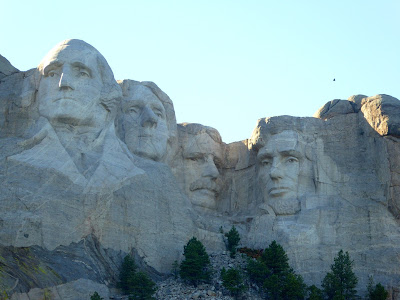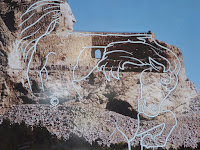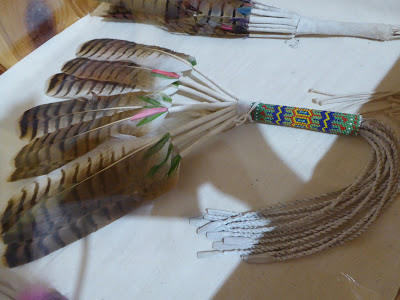ON THE TRAIL OF THE EARLY PIONEERS
CROSSING SOUTH DAKOTA TO NEBRASKA AND SOUTHEAST
WYOMING
August 26-28, 2015
After leaving the
Black Hills in South Dakato, Wounded Knee Massacre Historical Site was our next
destination stop ahead before heading into Nebraska. It became a rather long
boring drive across miles of prairie land to reach the Pine Ridge Indian
Reservation where the site is located. We had no specific GPS address for the historical
site other than a AAA map point indicating its location. the massacre site of
Big Foot’s Sioux Indian tribe of
300 by the 9th U.S. Calvary on December 29, 1890 was supposed to be
outside the reservation town of
 Wounded Knee seven miles southeast near Batesland,
SD. We missed the mark lost, passed through more and more miles of prairie land,
never turned back, and rerouted south through Nebraska to another landmark. Having seen the
historic exhibit about the winter massacre of Big Foot’s people while visiting Wall,
SD on our way to the Dakota Badlands previously it wasn’t like that piece of South Dakota
Wounded Knee history had been overlooked.
Wounded Knee seven miles southeast near Batesland,
SD. We missed the mark lost, passed through more and more miles of prairie land,
never turned back, and rerouted south through Nebraska to another landmark. Having seen the
historic exhibit about the winter massacre of Big Foot’s people while visiting Wall,
SD on our way to the Dakota Badlands previously it wasn’t like that piece of South Dakota
Wounded Knee history had been overlooked. |
| Big Foot was ill and came to sign a peace treaty. After General Custer and his regiment had been killed U.S. troops feared Indian retaliation and at Wounded Knee sadly the massacre of women and children left to die rested in the snow for days |

 |
| Wounded Knee Massacre Burial Site is sacred ground on the PineRidge Indian Reservation today. Some say the cries of Ghost Dancers can still be heard. |
 |
| Chimney Rock |
By 5:00 p.m, as tired road warriors that
gray skied hazy day, we pulled our rig into Pioneer Crossing Campground at
Bayard, Nebraska. The view of Chimney Rock just out the front window a mile away made the
day’s prairie crossing a milestone. Much like the early wagon trains between
1812-1866 along the California and Oregon Trails heading west the landmark of
Chimney Rock was a welcoming site for the night. In the 1800s a covered wagon
considered it lucky to cover seven to ten miles per day. Our triple tow modern
day wagon crossed 325 miles of prairie grassland in a day.
Bet those emigrant pioneers of long ago would have pined for a cold beer and soda with homemade tacos like our supper as their wagon trains circled up for the evening.
Bet those emigrant pioneers of long ago would have pined for a cold beer and soda with homemade tacos like our supper as their wagon trains circled up for the evening.
Along the 1849 Oregon Trail on a Wagon Train
OR
Perhaps even consider the Buckingham 2015 Triple Tow Wagon Train
Chimney Rock is impressive in its own right...stretching up for about 250 feet on top
of a hill. I was a bit mesmerized by this geological wonder even though it was at a much smaller scale than previously envisioned. Camped nearby I went outside in the darkness before twilight with my camera to catch a photo at sunrise, and was
amazed to find that Chimney Rock was also lit by floodlights at night. What a
sight!

 The Visitors Center nearby that following morning really helped to flesh
out the story, telling us how early settlers saw this as a landmark on their
journeys. We read the rock was actually taller than
what we currently see, that erosion has eroded it down over 150 years to what it is today.
The Visitors Center nearby that following morning really helped to flesh
out the story, telling us how early settlers saw this as a landmark on their
journeys. We read the rock was actually taller than
what we currently see, that erosion has eroded it down over 150 years to what it is today.
I
was impressed by the warning signs all around the building that read "Caution: This
is rattlesnake country. Stay off the grass". The pioneers dealt with many hardships...how soft we are nowadays !
Chimney Rock's landmark was a sign that those partaking on the Oregon Trail had
come 1/3 of the way, but that they still had the mountains and 2/3 more of
their journey. Ironically today marks 1/3 of the way on our 2015's three month trip, and
we still have the Rocky Mountains of Colorado and 2/3 more of the way to go on a different trail.
Crossing half of South Dakota and Nebraska in a day wasn’t too bad, but in contrast to our modern highway travel the pace was painfully slow, hot, dusty and dangerous for tens of thousands of emigrant wagons coming west in America. However, that’s a story for another time.
Crossing half of South Dakota and Nebraska in a day wasn’t too bad, but in contrast to our modern highway travel the pace was painfully slow, hot, dusty and dangerous for tens of thousands of emigrant wagons coming west in America. However, that’s a story for another time.
Seventy-three miles west later in the afternoon our modern day wagon train arrived to Fort Laramie, Wyoming. Fort Laramie was a major trading post for early trappers and traders from 1825-1841. The demise of the buffalo trade ended stop on the way west for tens of thousands of settlers as a trading post and later became a military outpost. The problem is that it has a perception issue because it does not look nor did it ever look like the Hollywood version of a western fort with high walls and a large gate with cavalry troops riding out of the gates to fight the Indians. Settlers heading west used the fort as a place to rest and refit. The fort was a strong point to handle Indian problems when necessary. However, more people died of cholera disease at the fort than died in battle. The Lakota, Cheyene, and Arapahoe tribes in the region through the 1820'3 and 40's were peaceful traders so travelers were relatively safe from attack.
 |
| Captain's Quarters for company-grade officers |
 |
| Not exactly roughing it in the fort Captain's Quarters |
 |
| Time for resupplies at Fort Laramie before moving along the North Platte River |












































